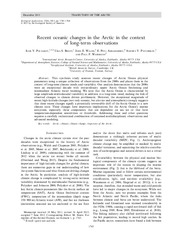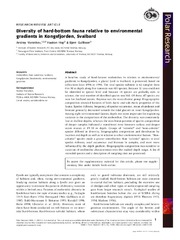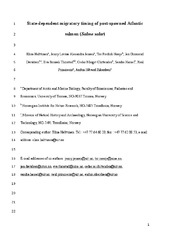Artikler, rapporter og annet (arktisk og marin biologi): Recent submissions
Now showing items 1481-1500 of 1643
-
Recent oceanic changes in the Arctic in the context of long-term observations
(Journal article; Tidsskriftartikkel; Peer reviewed, 2013)This synthesis study assesses recent changes of Arctic Ocean physical parameters using a unique collection of observations from the 2000s and places them in the context of long-term climate trends and variability. Our analysis demonstrates that the 2000s were an exceptional decade with extraordinary upper Arctic Ocean freshening and intermediate Atlantic water warming. We note that the Arctic ... -
Diversity of hard-bottom fauna relative to environmental gradients in Kongsfjorden, Svalbard
(Journal article; Tidsskriftartikkel; Peer reviewed, 2013)A baseline study of hard-bottom zoobenthos in relation to environmental gradients in Kongsfjorden, a glacial fjord in Svalbard, is presented, based on collections from 1996 to 1998. The total species richness in 62 samples from 0 to 30 m depth along five transects was 403 species. Because 32 taxa could not be identified to species level and because 11 species are probably new to science, the ... -
How rapidly do invasive birch forest geometrids recruit larval parasitoids? Insights from comparison with a sympatric native geometrid
(Journal article; Tidsskriftartikkel; Peer reviewed, 2013)Two related issues in studies of biological invasions are how quickly the enemy complexes of invasive species become as species-rich and efficient as those of native species and how important enemy release is for the establishment and spread of invaders. We addressed these issues for the geometrid moths Operophtera brumata and Agriopis aurantiaria, who invaded the coastal mountain birch forest ... -
Seasonal patterns in Arctic planktonic metabolism (Fram Strait - Svalbard region)
(Journal article; Tidsskriftartikkel; Peer reviewed, 2013)The metabolism of the Arctic Ocean is marked by extremely pronounced seasonality and spatial heterogeneity associated with light conditions, ice cover, water masses and nutrient availability. Here we report the marine planktonic metabolic rates (net community production, gross primary production and community respiration) along three different seasons of the year, for a total of eight cruises ... -
Warming of Atlantic Water in two west Spitsbergen fjords over the last century (1912-2009)
(Journal article; Tidsskriftartikkel; Peer reviewed, 2013)The recently observed warming of west Spitsbergen fjords has led to anomalous sea-ice conditions and has implications for the marine ecosystem. We investigated long-term trends of maximum temperature of AtlanticWater (AW) in two west Spitsbergen fjords. The data set is composed of more than 400 oceanographic stations for Isfjorden and Grønfjorden (78.18N), spanning from 1876 to 2009. Trends ... -
Trace elements and cathodoluminescence of detrital quartz in Arctic marine sediments - a new ice-rafted debris provenance proxy
(Journal article; Tidsskriftartikkel; Peer reviewed, 2013)The records of ice-rafted debris (IRD) provenance in the North Atlantic–Barents Sea allow the reconstruction of the spatial and temporal changes of ice-flow drainage patterns during glacial and deglacial periods. In this study a new approach to characterization of the provenance of detrital quartz grains in the fraction > 500 μm of marine sediments offshore of Spitsbergen is introduced, utilizing ... -
Outbreaks by canopy-feeding geometrid moth cause state-dependent shifts in understorey plant communities
(Journal article; Tidsskriftartikkel; Peer reviewed, 2013)The increased spread of insect outbreaks is among the most severe impacts of climate warming predicted for northern boreal forest ecosystems. Compound disturbances by insect herbivores can cause sharp transitions between vegetation states with implications for ecosystem productivity and climate feedbacks. By analysing vegetation plots prior to and immediately after a severe and widespread ... -
Experimentally determined temperature thresholds for Arctic plankton community metabolism
(Journal article; Tidsskriftartikkel; Peer reviewed, 2013)Climate warming is especially severe in the Arctic, where the average temperature is increasing 0.4 C per decade, two to three times higher than the global average rate. Furthermore, the Arctic has lost more than half of its summer ice extent since 1980 and predictions suggest that the Arctic will be ice free in the summer as early as 2050, which could increase the rate of warming. Predictions ... -
Local and regional determinants of colonisation-extinction dynamics of a riparian mainland-island root vole metapopulation
(Journal article; Tidsskriftartikkel; Peer reviewed, 2013)The role of local habitat geometry (habitat area and isolation) in predicting species distribution has become an increasingly more important issue, because habitat loss and fragmentation cause species range contraction and extinction. However, it has also become clear that other factors, in particular regional factors (environmental stochasticity and regional population dynamics), should be taken ... -
Floating Ice-Algal Aggregates below melting Arctic Sea Ice
(Journal article; Tidsskriftartikkel; Peer reviewed, 2013)During two consecutive cruises to the Eastern Central Arctic in late summer 2012, we observed floating algal aggregates in the melt-water layer below and between melting ice floes of first-year pack ice. The macroscopic (1-15 cm in diameter) aggregates had a mucous consistency and were dominated by typical ice-associated pennate diatoms embedded within the mucous matrix. Aggregates maintained ... -
The thuEFGKAB Operon of Rhizobia and Agrobacterium tumefaciens Codes for Transport of Trehalose, Maltitol, and Isomers of Sucrose and Their Assimilation through the Formation of Their 3-Keto Derivatives
(Journal article; Tidsskriftartikkel; Peer reviewed, 2013)The thu operon (thuEFGKAB) in Sinorhizobium meliloti codes for transport and utilization functions of the disaccharide trehalose. Sequenced genomes of members of the Rhizobiaceae reveal that some rhizobia and Agrobacterium possess the entire thu operon in similar organizations and that Mesorhizobium loti MAFF303099 lacks the transport (thuEFGK) genes. In this study, we show that this operon is ... -
Seasonality of occurrence and recruitment of Arctic marine benthic invertebrate larvae in relation to environmental variables
(Journal article; Tidsskriftartikkel; Peer reviewed, 2013)The Arctic system is one of the regions most influenced by ongoing global climate change, but there are still critical gaps in our knowledge regarding a substantial number of biological processes. This is especially true for processes taking place during the Arctic winter but also for seasonal processes, such as the dynamics of intra-annual meroplankton occurrence. Here, we report on a ... -
Diversity and abundance of water birds in a subarctic lake during three decades
(Journal article; Tidsskriftartikkel; Peer reviewed, 2013)The numbers of divers, ducks, gulls, terns and waders in the 15 km2 oligotrophic lake Takvatn, North Norway, were estimated six times during 1983-2012. Systematic mapping surveys were done by boat within the first week after the ice-break in June. Twenty-one species were observed over the years and 12 were regarded as breeding on the lake. Red-breasted merganser Mergus serrator was the dominant diving ... -
Speciation reversal in European whitefish (Coregonus lavaretus (L.)) caused by competitor invasion
(Journal article; Tidsskriftartikkel; Peer reviewed, 2014)Invasion of exotic species has caused the loss of biodiversity and imparts evolutionary and ecological changes in the introduced systems. In northern Fennoscandia, European whitefish (Coregonus lavaretus (L.)) is a highly polymorphic species displaying adaptive radiations into partially reproductively isolated and thus genetically differentiated sympatric morphs utilizing the planktivorous and ... -
State-dependent migratory timing of postspawned Atlantic salmon (Salmo salar)
(Journal article; Tidsskriftartikkel; Peer reviewed, 2013)Atlantic salmon (Salmo salar) often survive spawning and migrate back to the sea to feed, either shortly after spawning in autumn or the following spring. We conducted a 4-year observational field study using telemetry to evaluate the determinants of migration timing in Atlantic salmon postspawners (kelts). We found that individuals with low energy reserves migrated early to the risky but productive ... -
Experimental harvest reveals the importance of territoriality in limiting the breeding population of Svalbard rock ptarmigan
(Journal article; Tidsskriftartikkel; Peer reviewed, 2013)The Svalbard rock ptarmigan (Lagopus muta hyperborea) is an endemic subspecies of rock ptarmigan inhabiting the high Arctic archipelagos of Svalbard and Franz Josefs Land. This ptarmigan species exists at low population densities, with little interannual variations in population numbers, and limited habitat for breeding with less than 5 % of the land area in Svalbard constituting medium to high ... -
New insights into regulation of anthocyanin biosynthesis in fruits
(Journal article; Tidsskriftartikkel; Peer reviewed, 2013)Anthocyanins are important health-promoting pigments that make a major contribution to the quality of fruits. The biosynthetic pathway leading to anthocyanins is well known and the key regulatory genes controlling the pathway have been isolated in many species. Recently, a considerable amount of new information has been gathered on the developmental and environmental regulation of anthocyanin ... -
What are the impacts of reindeer/caribou (Rangifer tarandus L.) on arctic and alpine vegetation? A systematic review protocol
(Journal article; Tidsskriftartikkel; Peer reviewed, 2013)Abstract Background: Reindeer and caribou (both belonging to the species Rangifer tarandus L.) are among the most important large herbivores in Eurasia’s and North America’s arctic, alpine and boreal zones. In Sweden, the impact of reindeer grazing on arctic and alpine vegetation has recently been re-evaluated. In the 1990s, records of grazing-related vegetation degradation helped to form a ... -
Shedding new light on the diet of Norwegian lemmings: DNA metabarcoding of stomach content
(Journal article; Tidsskriftartikkel; Peer reviewed, 2013)Lemmings are key herbivores in many arctic food webs, and their population dynamics have major impacts on the functioning of tundra systems. However, current knowledge of lemming diet is limited, hampering evaluation of lemming–vegetation interactions. This lack of knowledge is mainly due to methodological challenges, as previously used microhistological methods result in large proportions of poorly ... -
Fjellrev i Finnmark : Årsrapport 2013
(Research report; Forskningsrapport, 2013)Prosjekt Fjellrev i Finnmark har pågått siden 2004. Prosjektet har fra starten av hatt to målsetninger: Å gjøre grunnleggende forskning på økosystembetingelser som begrenser fjellrevenbestandens nåværende utbredelse og bestandsvekst i Øst-Finnmark spesielt, og i sub- og lav-Arktis generelt, med fokus på to hypoteser; a) mer uregelmessige og dempede smågnagersykler og b) øket konkurranse med ...


 English
English norsk
norsk


















